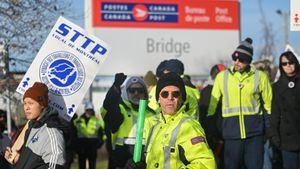The United States grapples with numerous missing persons cases, some of which capture national attention, highlighting systemic issues within communities and law enforcement. Families and advocates are raising alarms about the disproportionately high number of missing persons, particularly among minorities and vulnerable populations.
Take the case of Mia, a 24-year-old woman who disappeared last March from her hometown of St. Louis, Missouri, igniting concern and community engagement. Despite efforts by her family to spread the word via social media and community flyers, Mia’s case saw little initial traction from local media or law enforcement. This lack of immediate attention is not uncommon for women of color like Mia, according to reports. Many families of missing minorities report feeling sidelined when it’s their loved ones who vanish. “We’re often just not seen. It’s like our cries are muffled,” Mia's mother lamented.
Notably, the phenomenon of missing persons varies greatly across racial lines. A study found Black individuals go missing at rates 2.5 times higher than their white counterparts, with many cases remaining unresolved for years. This is attributed to systemic biases within law enforcement as they often prioritize cases of white individuals, particularly when they fit the stereotype of the 'all American' victim. Such trends point toward the need for reform and greater accountability within police departments to address these disparities.
The case of Summer Wells, the five-year-old girl who vanished from her home last year, struck home for many across America. Her story took over social media platforms and captivated national news cycles, leading to extensive search efforts involving hundreds of volunteers, search dogs, and drones. While Summer's case illuminates public dedication and resources for one child’s search, it raises unsettling questions. Why did other cases with less media attention not receive similar support?
This question poses broader concerns about community involvement and awareness, which seemed to increase dramatically following Summer's disappearance. Community members started forming search parties and setting up volunteer stations, inspired by the mobilization around her case. Advocates argue this sort of grassroots activism needs to be more proactive as potential victims emerge long before they go missing. "We need to actively build networks against such tragedies—be vigilant and ready before someone disappears," said community organizer, Rita Johnson.
The role of social media cannot be overstated. Platforms like Facebook, Twitter, and TikTok have evolved as powerful tools not only for sharing missing person reports but also for creating meaningful dialogues about the underlying issues surrounding these cases. A case out of California, where the hashtag #FindAshley went viral, led to widespread media coverage and new leads when the community rallied together online. Supporters utilized digital platforms to amplify voices often drowned out by silence, spurring new tips and leads.
Despite these positive outcomes, the digital approach also has its downsides. Misinformation can spread easily, which sometimes leads to unfounded panic or potentially harmful theorizing about what might have happened to the missing individuals. The case of Ashley was no exception, spiraling narratives surrounding her whereabouts, confounding the investigation, and frustrating law enforcement officials. “We need responsibility with how we share information. A rumor can damage real investigations,” one detective stated, urging for trust between the public and law enforcement when dealing with such sensitive and complex matters.
More resources are desperately needed to address the larger systemic issues associated with missing persons. Experts recommend regular training programs for law enforcement agencies on minority sensitivity and community representation to restructure how missing persons cases are approached. “A first responder’s training is not just about techniques; it’s about empathy,” said Dr. Aisha Roberts, leading sociologist focusing on systemic biases.
Legislative action is also underway, with several states discussing proposals aimed at developing comprehensive databases for missing persons, emphasizing the necessity for transparency and more rigorous investigative methods. Critically endorsed by activists across the country, these databases aim to work alongside community outreach programs for improving collaboration between families, law enforcement, and local organizations.
Monthly vigils have sprouted up, uniting grieving families and friends of missing individuals. These gatherings not only honor the ones lost but also allow for solidarity and shared strategies among families feeling lost themselves. “It’s comforting to know others feel this pain,” Mia's mom said at one such vigil recently.
Yet even with the community’s commitment, electronic databases, and national campaigns, the fight against the missing persons crisis persists. Activists are unrelenting, pushing for systemic changes to prevent other families from enduring similar heartbreak. They stress the importance of viewing the cases through the lens of humanity, urging families to reflect on stories rather than statistics.
The battle against the epidemic of missing persons remains fraught with challenges. But the constant push from families, communities, and online movements is illuminating pathways for change, sparking conversations, and sometimes, bringing families closer to closure. The question for many now becomes: how can we continue this momentum and create lasting solutions to end the crisis for good?



